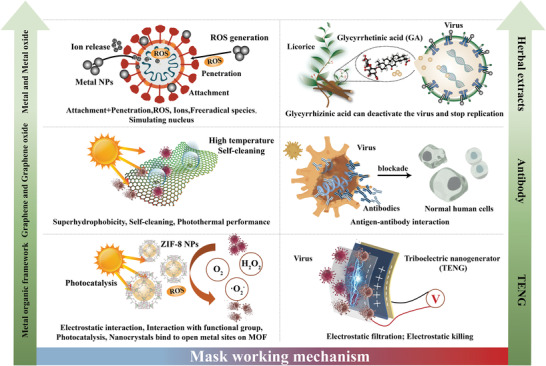Figure 6.

The working mechanisms of multifunctional masks modified with different materials or technologies: a) Metal and metal oxide: 1) Nanoparticles (NPs) attach themselves to the virus, which disrupts the virus from attaching itself onto a potential host cell. 2) NPs produce oxygen, ions and free radical species which are highly reactive. These species then adhere to the membrane walls of microorganisms, reacting with them and potentially destroying the virus's structure and disrupting protein and nucleic acid production. 3) NPs indirectly destroy viruses by activating the immune response of infected cells by stimulating their nuclei – this inhibits the spread of virus. b) Bio‐based or herbal extracts: licorice root is used to fabricate the nanofibers due to its viral inactivation compounds including glycyrrhizin (GL) and glycyrrhetinic acid (GA), which possess an antimicrobial capacity. c) Graphene and graphene oxide: Masks can get benefits that exhibit outstanding performances such as super‐hydrophobicity, self‐cleaning, self‐reporting and excellent photothermal capabilities – addressing limitations found in current ordinary surgical masks. d) Antibody: The use of filters containing ostrich antibodies may be an effective way to prevent virus transmission. e) Metal organic framework (MOF): 1) electrostatic interaction with MOF, 2) interaction with functional groups on MOF and/or polymers, and 3) nanocrystals binding to open metal sites on MOF. f) Triboelectric nanogenerator (TENG): generating electrostatic charges prolong the service time and enhance filtration efficiency while at the same time potentially killing the virus.
